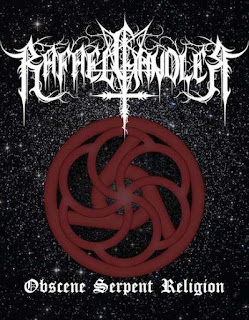 |
| You are not trve kvlt if you can't decipher the author's name. |
The book is made of 32 weird 7.5 x 7.5 inch sized square pages. The cover looks like that of a death or black metal album's, and the black & white interior follows the gimmick too. Needless to say, those faint of heart should avoid the product, for there is plenty of gore and nudity within. Most illustrations are exceptionally well done and detailed, save for the last one which looks like something made with Microsoft Paint.
The first half of the supplement is about generating the features of the cult. You can find out what are they ways of the church, who the goddess is, what her teachings are, what missions do the leaders send the members on, et cetera. We aren't talking about tables here in the traditional sense. Each element has six possible results, each explained in a few paragraphs. While six doesn't seem too much, there is plenty of rolling to do until you get the end result, thus it's unlikely you will end up with a similar outcome after multiple usage.
The entries show a rampant imagination behind them. They can add a lot of depth and character to the sect, and can fire up the GM's creativity about how to further expand them - especially the bizarre, seemingly contradictory combinations. The author also proves that serpent faiths don't necessarily mean cloaked dudes worshipping ophidians - they can also be fertility cults, art idolizers, fortune seekers.
My favorite results are those with an ancient, mythic feel. For example:
"She gave birth to the moon, which was the first egg, and when it hatches, all will be devoured. She immolated her husband, who became the sun. His name is forgotten, for he is of no consequence. The Goddess is life, the Goddess is all."
That's evocative, and if you roll with it as truth it can bring some unique flavor to your campaign world. The moon is way too often underused in fantasy campaigns anyway, surprising your players with turning it to a literal snake egg sounds way too cool to not use it once in your life.
Unfortunately the book is not devoid of the edginess of typical LotFP products. Case in point, here is a quest for advancement within the cult:
"In a public place, you must force a serpent into the body of a powerful foe with many allies. The result must be fatal, regardless of whether the serpent is shoved into the victim’s mouth, or into a wound, or in some other part of the body."
I like the irony how the hole everyone first will think of is not mentioned among the examples. Still, the above was one of the tame options. There are others with more mutilation and sadism. Around the Tenets of Faith and Quests for the Hexagram was where I noticed the major difference between OSR2 and OSR1: the former pits the PCs against a cult, while the latter assumes they are the members of one. While I have no issue with having a serpent-worshipper or two in the party, I would avoid most of the tenets and quests presented, because they are just wanton torture porn.
After generating the faith's details come the appendices. The first is for generating random NPCs, and has plenty of names, epithets, situations. The only place where its lacking is the random items they are carrying. The second is encounters in the wilderness. It requires three rolls too to find out who the party meeets, what they are doing, and what they are carrying. Solid chart, well worth injecting into your campaign if the serpent cult becomes a prominent feature of it. Third and fourth are two magic items. Sable Nectar is created from Sweet Nectar and the blood of a half-serpent creature. The juice grants random bonuses for 1d6 hours, at a cost - like blindness, or losing abiltiy score. Scarlet Nectar is made of Sweet Nectar and the blood of a snake. Its effects depend on what kind of snake's blood was used. Predictability has its cost too, though: drinking Scarlet Nectar is considered blasphemy by snake cults. The book ends with stats for Skin Vessels, which follows the good old (but not overused) cliché of a body filled with wriggling and writhing creatures - this time with snakes, of course.
Obscene Serpent Religion is a mixed bag. It's an evocative book, but some of the ideas you can end up with don't live up to their full potential. I understand it was meant to be an LotFP product. It's just a pity that if it wasn't one, it could have ended up with being something so much more. Its usefulness can also be limited depending on how prominent role are you planning to give the serpent cult(s) in your campaign. Still, it's a relatively cheap sourcebook with some excellent ideas. Having it on your shelf won't hurt.
Tl;dr: Obscene Serpent Religion is an imaginative supplement that limits its potential to fit the grimdark edgy weird fantasy of LotFP. You can buy the pdf on DriveThruRPG, and the paperback on Lulu.
Disclaimer: The DriveThruRPG links on this site are affiliate links. If you buy something through the link we'll get some credit for your purchase too.
May have to check it out. Always enjoyed snake cults.
ReplyDeleteYes, snakes cults are cool, although I prefer frog cults. Is there a book with charts for generating random animal cults? There should be one...
Delete